#Global Research Institute of Management and Research
Explore tagged Tumblr posts
Text
Older trees are able to accelerate their rates of absorbing planet-warming emissions, scientists at the University of Birmingham have found. A forest of mature oak trees was exposed to elevated levels of carbon dioxide for seven years and in response, the trees increased their production of wood - locking in the greenhouse gas and preventing it from warming the planet. The researchers hope the study, published in Nature Climate Change, will demonstrate the importance of protecting and maintaining mature forests for tackling climate change.
[...]
"I think it is a hopeful and positive story," said Professor Rob MacKenzie, director of Birmingham Institute of Forest Research and one of the co-authors of the study. "This is evidence in favour of careful management of established forests. The old forest is doing a huge amount of work for us. What we definitely should not be doing is cutting it down," he said.
[...]
Prof MacKenzie told the BBC it was important for the team to understand how older trees behave as that is the majority of the tree cover we have globally. Although the results are positive he warned: "This absolutely is not a silver bullet and a get out of jail free card our fossil fuel emissions." "There's absolutely no way we could transform the world into enough forest to continue to let us burn fossil fuels in the way that we are doing now," he said.
12 August 2024
454 notes
·
View notes
Text
My alternate universe fantasy colonial Hong Kong is more authoritarian and just as racist but less homophobic than in real life, should I change that?
@floatyhands asked:
I’m a Hongkonger working on a magical alternate universe dystopia set in what is basically British colonial Hong Kong in the late 1920s. My main character is a young upper middle-class Eurasian bisexual man. I plan to keep the colony’s historical racial hierarchy in this universe, but I also want the fantasy quirks to mean that unlike in real life history, homosexuality was either recently decriminalized, or that the laws are barely enforced, because my boy deserves a break. Still, the institutions are quite homophobic, and this relative tolerance might not last. Meanwhile, due to other divergences (e.g. eldritch horrors, also the government’s even worse mishandling of the 1922 Seamen's Strike and the 1925 Canton-Hong Kong Strike), the colonial administration is a lot more authoritarian than it was in real history. This growing authoritarianism is not exclusive to the colony, and is part of a larger global trend in this universe. I realize these worldbuilding decisions above may whitewash colonialism, or come off as choosing to ignore one colonial oppression in favor of exaggerating another. Is there any advice as to how I can address this issue? (Maybe I could have my character get away by bribing the cops, though institutional corruption is more associated with the 1960s?) Thank you!
Historical Precedent for Imperialistic Gay Rights
There is a recently-published book about this topic that might actually interest you: Racism And The Making of Gay Rights by Laurie Marhoefer (note: I have yet to read it, it’s on my list). It essentially describes how the modern gay rights movement was built from colonialism and imperialism.
The book covers Magnus Hirschfeld, a German sexologist in the early 1900s, and (one of) his lover(s), Li Shiu Tong, who he met in British Shanghai. Magnus is generally considered to have laid the groundwork for a lot of gay rights, and his research via the Institut für Sexualwissenschaft was a target of Nazi book-burnings, but he was working with imperial governments in an era where the British Empire was still everywhere.
Considering they both ended up speaking to multiple world leaders about natural human sexual variation both in terms of intersex issues and sexual attraction, your time period really isn’t that far off for people beginning to be slightly more open-minded—while also being deeply imperialist in other ways.
The thing about this particular time period is homosexuality as we know it was recently coming into play, starting with the trial of Oscar Wilde and the rise of Nazism. But between those two is a pretty wildly fluctuating gap of attitudes.
Oscar Wilde’s trial is generally considered the period where gay people, specifically men who loved men, started becoming a group to be disliked for disrupting social order. It was very public, very scandalous, and his fall from grace is one of the things that drove so many gay and/or queer men underground. It also helped produce some of the extremely queercoded classical literature of the Victorian and Edwardian eras (ex: Dracula), because so many writers were exploring what it meant to be seen as such negative forces. A lot of people hated Oscar Wilde for bringing the concept to such a public discussion point, when being discreet had been so important.
But come the 1920s, people were beginning to wonder if being gay was that bad, and Mangus Hirschfeld managed to do a world tour of speaking come the 1930s, before all of that was derailed by wwii. He (and/or Li Shiu Tong) were writing papers that were getting published and sent to various health departments about how being gay wasn’t an illness, and more just an “alternative” way of loving others.
This was also the era of Boston Marriages where wealthy single women lived together as partners (I’m sure there’s an mlm-equivalent but I cannot remember or find it). People were a lot less likely to care if you kept things discreet, so there might be less day to day homophobia than one would expect. Romantic friendships were everywhere, and were considered the ideal—the amount of affection you could express to your same-sex best friend was far above what is socially tolerable now.
Kaz Rowe has a lot of videos with cited bibliographies about various queer disasters [affectionate] of the late 1800s/early 1900s, not to mention a lot of other cultural oddities of the Victorian era (and how many of those attitudes have carried into modern day) so you can start to get the proper terms to look it up for yourself.
I know there’s a certain… mistrust of specifically queer media analysts on YouTube in the current. Well. Plagiarism/fact-creation scandal (if you don’t know about the fact-creation, check out Todd in the Shadows). I recommend Kaz because they have citations on screen and in the description that aren’t whole-cloth ripped off from wikipedia’s citation list (they’ve also been published via Getty Publications, a museum press).
For audio-preferring people (hi), a video is more accessible than text, and sometimes the exposure to stuff that’s able to pull exact terms can finally get you the resources you need. If text is more accessible, just jump to the description box/transcript and have fun. Consider them and their work a starting place, not a professor.
There is always a vulnerability in learning things, because we can never outrun our own confirmation bias and we always have limited time to chase down facts and sources—we can only do our best and be open to finding facts that disprove what we researched prior.
Colonialism’s Popularity Problem
Something about colonialism that I’ve rarely discussed is how some colonial empires actually “allow” certain types of “deviance” if that deviance will temporarily serve its ends. Namely, when colonialism needs to expand its territory, either from landing in a new area or having recently messed up and needing to re-charm the population.
By that I mean: if a fascist group is struggling to maintain popularity, it will often conditionally open its doors to all walks of life in order to capture a greater market. It will also pay its spokespeople for the privilege of serving their ends, often very well. Authoritarians know the power of having the token supporter from a marginalized group on payroll: it both opens you up directly to that person’s identity, and sways the moderates towards going “well they allow [person/group] so they can’t be that bad, and I prefer them.”
Like it or not, any marginalized group can have its fascist members, sometimes even masquerading as the progressives. Being marginalized does not automatically equate to not wanting fascism, because people tend to want fascist leaders they agree with instead of democracy and coalition building. People can also think that certain people are exaggerating the horrors of colonialism, because it doesn’t happen to good people, and look, they accept their friends who are good people, so they’re fine.
A dominant fascist group can absolutely use this to their advantage in order to gain more foot soldiers, which then increases their raw numbers, which puts them in enough power they can stop caring about opening their ranks, and only then do they turn on their “deviant” members. By the time they turn, it’s usually too late, and there’s often a lot of feelings of betrayal because the spokesperson (and those who liked them) thought they were accepted, instead of just used.
You said it yourself that this colonial government is even stricter than the historical equivalent—which could mean it needs some sort of leverage to maintain its popularity. “Allowing” gay people to be some variation of themselves would be an ideal solution to this, but it would come with a bunch of conditions. What those conditions are I couldn’t tell you—that’s for your own imagination, based off what this group’s ideal is, but some suggestions are “follow the traditional dating/friendship norms”, “have their own gender identity slightly to the left of the cis ideal”, and/or “pretend to never actually be dating but everyone knows and pretends to not care so long as they don’t out themselves”—that would signal to the reader that this is deeply conditional and about to all come apart.
It would, however, mean your poor boy is less likely to get a break, because he would be policed to be the “acceptable kind of gay” that the colonial government is currently tolerating (not unlike the way the States claims to support white cis same-sex couples in the suburbs but not bipoc queer-trans people in polycules). It also provides a more salient angle for this colonial government to come crashing down, if that’s the way this narrative goes.
Colonial governments are often looking for scapegoats; if gay people aren’t the current one, then they’d be offered a lot more freedom just to improve the public image of those in power. You have the opportunity to have the strikers be the current scapegoats, which would take the heat off many other groups—including those hit by homophobia.
In Conclusion
Personally, I’d take a more “gays for Trump” attitude about the colonialism and their apparent “lack” of homophobia—they’re just trying to regain popularity after mishandling a major scandal, and the gay people will be on the outs soon enough.
You could also take the more nuanced approach and see how imperialism shaped modern gay rights and just fast-track that in your time period, to give it the right flavour of imperialism. A lot of BIPOC lgbtqa+ people will tell you the modern gay rights movement is assimilationalist, colonialist, and other flavours of ick, so that angle is viable.
You can also make something that looks more accepting to the modern eye by leaning heavily on romantic friendships that encouraged people waxing poetic for their “best friends”, keeping the “lovers” part deeply on the down low, but is still restrictive and people just don’t talk about it in public unless it’s in euphemisms or among other same-sex-attracted people because there’s nothing wrong with loving your best friend, you just can’t go off and claim you’re a couple like a heterosexual couple is.
Either way, you’re not sanitizing colonialism inherently by having there be less modern-recognized homophobia in this deeply authoritarian setting. You just need to add some guard rails on it so that, sure, your character might be fine if he behaves, but there are still “deviants” that the government will not accept.
Because that’s, in the end, one of the core tenants that makes a government colonial: its acceptance of groups is frequently based on how closely you follow the rules and police others for not following them, and anyone who isn’t their ideal person will be on the outs eventually. But that doesn’t mean they can’t have a facade of pretending those rules are totally going to include people who are to the left of those ideals, if those people fit in every other ideal, or you’re safe only if you keep it quiet.
~ Leigh
#colonialism#colonization#worldbuilding#alternate history#history#lgbt#china#hong kong#british empire#ask
595 notes
·
View notes
Text
In a recent report published by Open Research Africa discussing disparities in Covid-19 research funding and leadership, scientists revealed that the majority of Long Covid research in Africa is primarily financed and overseen by foreign nations. The report’s authors analyzed projects documented in a global database tracking funded Covid-19 research projects. Out of a staggering 17,995 research projects cataloged in the Tracker as of July 2022, only 786 were carried out in African countries. Noteworthy contributors to Covid-19 research efforts on the continent included Morocco, with 183 projects, South Africa with 128 projects, and Kenya with 91 projects. In total, 75 research funders representing 17 countries directed USD $267 million to Covid-19 research in Africa. But the funders of these projects were predominantly public or governmental organizations from Europe and the U.S. Institutions such as the National Center for Scientific and Technical Research and UK Research and Innovation led the charge. While the bulk of funding stemmed from international entities, nine funders based in Africa also contributed to the cause. This imbalance in research investments poses a challenge for African scientists, as local research needs may differ from external agendas. The lack of sufficient evidence produced within and in the context of Africa worsens the marginalization of Long Covid in the region and weakens attempts to advocate for its acknowledgment and management.
110 notes
·
View notes
Text
[“Many years ago when the Channel Tunnel—connecting England and France—was being built (1986–1992), I got the chance to talk to a nurse working on the project on the English side. The project was big, deadlines were tight, and the workers, she told me, were suffering terrible conditions in the tunnel (a total of ten workers died during the construction (Smith 2015)). I wondered how complicated her job was as part of the onsite health personnel for such a large project. Not very. “The men mostly come to me complaining of terrible headaches,” she explained, “my job is to give them two aspirin and get them back down the tunnel as quickly as possible.”
Speaking of medicine under capitalism, Waitzkin (2000: 37) notes the fundamental contradiction between the perception of health as the ultimate “caring profession” and a society which establishes obstacles to the goal of alleviating “needless suffering and death,” for “[t]he social organization of medicine also fosters patterns of oppression that are antithetical to medicine’s more humane purposes. These patterns within medicine mirror and reproduce oppressive features of the wider society as well.”
Marxist scholars of medicine have theorised this replication of the wider class struggle within the health system in a number of ways. First, the priorities of the institution favour those of capitalism and the ruling class. For example, the modern system of health care emerged out of the need for a healthier and more reliable industrial workforce (Waitzkin 2000: 48); concern for the health of the working classes has tended to peak when there are imperialist wars to be fought, while the majority of current medical research prioritises lifestyle and “me too” cosmetic treatments for the global market rather than research on life-saving treatments for cancer and infectious diseases (see, e.g., Rapaport 2015). Second, the exploitative work relations within capitalist societies are replicated within the rigid hierarchy of medicine, with high-waged, upper middle-class consultants holding a great amount of decision-making power at the top, the lower middle-class nursing managers administering consultants’ needs in the middle, and—holding no power whatsoever and subject to the whims of health managers—the low-earning working-class orderlies and auxiliary staff at the bottom of the pyramid. Navarro (1976: 446) also notes the tendency of the medical profession to maintain and reinforce these class relations through “both the distribution of skills and knowledge and the control of technology” within the health service. Third, the health system functions as an institution of social control. That is, it reinforces the dominant values and norms of capitalism through its surveillance and labelling practices. In the words of Freidson (1988: 252), medicine acts as a “moral entrepreneur” to the extent that illness is viewed negatively and as something to be “eradicated or contained.” Even cancer, he states, is a social valuation by the profession, a moral rather than an objective judgement of the body, even if it is one “on which most people happen to agree” (Freidson 1988: 252).
Taking a Marxist approach to medicine includes recognising the policing function of the health professions to label and “medicalise” social deviance as illness, as well as reinforce the ideological prerogatives of capitalism as natural and common sense (for instance, through biomedical interventions focused on the individual rather than the wider social environment).
The social control function within psy-professional work practices and knowledge claims is reasonably easy to identify and has been a major focus of critical scholars—Marxist and otherwise—since the 1960s (see, e.g., Conrad 1975; Goffman 1961; Rosenhan 1973; Scheff 1966). The moral judgements that mental health experts make of people’s behaviour under the claims of scientific neutrality and objectivity allow them to sanction forms of deviance which run contrary to the prevailing social order. For example, Szasz (cited in Freidson 1988: 249) stated in 1964 that “agoraphobia is illness because one should not be afraid of open spaces. Homosexuality is an illness because heterosexuality is the social norm. Divorce is illness because it signals failure of marriage.”
Specifically, Marxist contentions of the psy-professions as agents of social control focus on the ways in which these experts contribute to the alienation of people from their own creative abilities. These experts utilise their knowledge claims on human behaviour to depoliticise attempts at social transformation at the group and community level, in turn acknowledging only individual solutions as possible. Consequently, states Parker (2007: 2), this “psychologisation of social life” performed by mental health workers “encourages people to think that the only possible change they could ever make would be in the way they dress and present themselves to others.”]
bruce m.z. cohen, from psychiatric hegemony: a marxist theory of mental illness, 2016
48 notes
·
View notes
Text
hadn't seen this on here yet
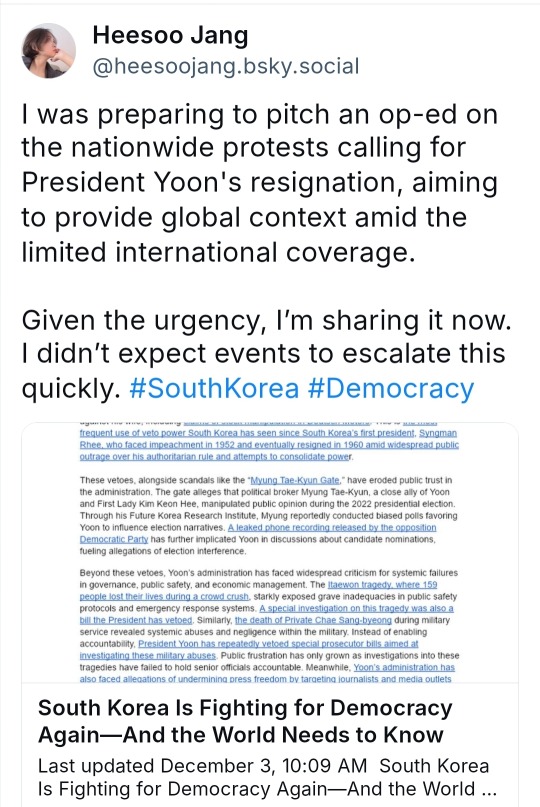
South Korea Is Fighting for Democracy Again—And the World Needs to Know
by Heesoo Jang
Assistant Professor of Media Law and Ethics, Journalism Department, University of Massachusetts Amherst
South Korea is once again at a critical juncture in its democratic history. More than a hundred thousand protesters, joined by over 4,000 professors and 1,466 Catholic priests announcing their declarations of the state of affairs, are calling for President Yoon Suk Yeol’s resignation. This echoes the massive movement that led to the impeachment of President Park Geun-hye in 2017 for corruption and abuse of power, showcasing South Koreans’ enduring commitment to holding leaders accountable.
What’s unfolding in South Korea is not just a domestic issue—it’s a reminder that democracies everywhere require constant vigilance. Yet, international media, like the BBC and AP News, have largely missed the bigger picture, focusing on soundbites and foreign policy instead of the underlying democratic struggles. This oversight leaves out important context for the global audience to understand the deeper context of widespread domestic dissatisfaction of the state of democracy in South Korea.
At the heart of the protests are allegations of corruption and abuse of power. President Yoon has exercised his veto power 25 times since 2023, blocking investigations into allegations against his wife, including claims of stock manipulation in Deutsch Motors. This is the most frequent use of veto power South Korea has seen since South Korea’s first president, Syngman Rhee, who faced impeachment in 1952 and eventually resigned in 1960 amid widespread public outrage over his authoritarian rule and attempts to consolidate power.
These vetoes, alongside scandals like the “Myung Tae-Kyun Gate,” have eroded public trust in the administration. The gate alleges that political broker Myung Tae-Kyun, a close ally of Yoon and First Lady Kim Keon Hee, manipulated public opinion during the 2022 presidential election. Through his Future Korea Research Institute, Myung reportedly conducted biased polls favoring Yoon to influence election narratives. A leaked phone recording released by the opposition Democratic Party has further implicated Yoon in discussions about candidate nominations, fueling allegations of election interference.
Beyond these vetoes, Yoon’s administration has faced widespread criticism for systemic failures in governance, public safety, and economic management. The Itaewon tragedy, where 159 people lost their lives during a crowd crush, starkly exposed grave inadequacies in public safety protocols and emergency response systems. A special investigation on this tragedy was also a bill the President has vetoed. Similarly, the death of Private Chae during military service revealed systemic abuses and negligence within the military. Instead of enabling accountability, President Yoon has repeatedly vetoed special prosecutor bills aimed at investigating these military abuses. Public frustration has only grown as investigations into these tragedies have failed to hold senior officials accountable. Meanwhile, Yoon’s administration has also faced allegations of undermining press freedom by targeting journalists and media outlets critical of the government.
Adding to these failures is a healthcare system on the brink of collapse, where prolonged medical staff shortages, exacerbated by budget cuts, have caused long-term disruptions in patient care. Instead of addressing these structural issues, the government has opted for a hasty increase in medical school quotas—a move experts warn will only further destabilize the system. Yoon’s economic policies have similarly drawn heavy criticism for favoring the wealthy with tax cuts while reducing public welfare budgets, deepening inequality between South Korea’s elites and its struggling middle and working classes. Rising household debt and record-breaking small business closures have fueled calls for reform, yet the administration’s inaction has only alienated the public further. Compounding these grievances, a 15% cut to South Korea’s research and development (R&D) budget has alarmed academics and scientists, who warn that this decision jeopardizes the nation’s innovation-driven economy and long-term global competitiveness—a concern echoed by prominent universities like Yonsei and Ewha Womans University, which cite these cuts as emblematic of broader governance failures.
Despite the scale of unrest, international media have failed to convey the full significance of this crisis. Instead of contextualizing public discontent and the erosion of democratic norms, they have focused on peripheral issues, ignoring the protests’ broader implications for democracy. This has also allowed misinformation to muddy the narrative internationally, preventing the international public from gaining important contextual information about what’s happening in South Korea. For example, posts on Chinese social media have falsely portrayed the protests as anti-war rallies rather than demands for accountability and reform.
South Korea’s struggle is a powerful reminder that democracy is not self-sustaining—it requires active vigilance. The protests and demands for reform exemplify how civil society can confront governance failures. The world deserves more context and a nuanced understanding from international journalism about what South Korean democracy is facing, as its fight for justice, transparency, and the rule of law holds lessons for all democracies.
#south korea#sk politics#bluesky#hesoo jang#please click through to the doc for links because there are many
44 notes
·
View notes
Note
Top 5 archaeological sites in Australia that you feel people should know more about? Or top 5 Australian artefacts?
I feel like I’ve talked a bit about artefacts in a few recent asks, and also I feel like a lot of Australian archaeology (and as such, sites) are very underrated, particularly on a global scale. Its often acknowledged in Australian archaeology that getting international academia to recognise the importance of our country’s archaeology is very very difficult.
While there’s a million and one sites I’d love to talk about, I’m going to TRY and give sites that relate to different aspects and locations
This is probably going to be long, so...
1. Nauwalabila, Madjedbebe (Malakunanja II), and the Deaf Adder Gorge region, Northern Territory (Aboriginal)
Rock shelters in this region, and specifically Madjedbebe, are currently the oldest location of human habitation in Australia. Dating evidence from 2017 excavations provided an estimate of earliest occupation of 50 000 years at certainty, possibly extending back as early as 65 000 (+/-6000). It also has provided a lot of evidence for research into the extensive grind stone technologies of the Pleistocene.
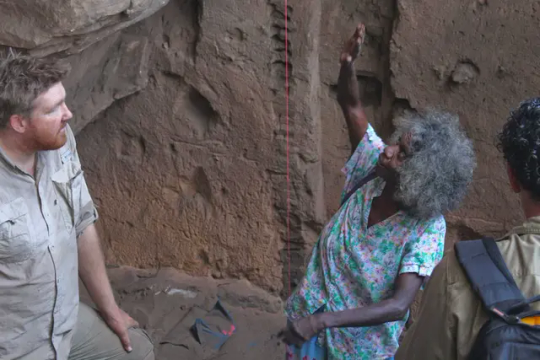
2. Cloggs Cave and the Buchan region of the Victorian Gippsland (Aboriginal)
So much research has been done into this region in various ways. Josephine Flood focused her research on Bogong Moth usage (and festivals) within this region, providing some of the earliest accepted academic research in support of Aboriginal peoples’ claims of large scale Bogong Moth Festivals in Australia’s highlands (although the fac that no one really believed communities until then…………..). In 2021 grind analysis found Bogong Moth residue, making this the earliest stone artefact with evidence of insect food remains. And in addition to that recent 2017 research in the area investigated Holocene occupation with Aboriginal community members, with a focus on understanding the interaction of spirituality with the resources found in the caves.
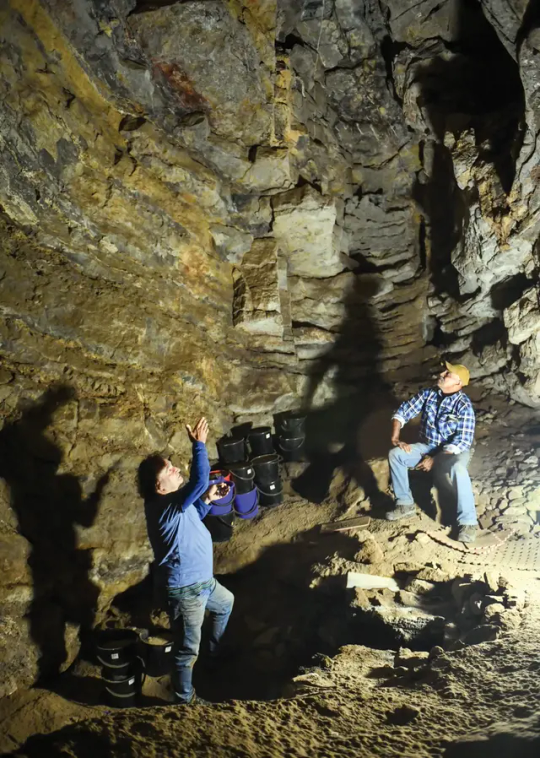
3. Mabuyag Island, Torres Strait Islands, Queensland (Torres Strait Islander)
Mabuyag Island (alternatively known as Mabuiag or Mabuyaagi) has archaeological evidence of human occupation since 7300 years ago. The island is both associated with recent religious practices associated with he heavy processing of dugong remains, and totemic associations with these, which played a role in early 2000s into community lead and directed archaeological research into ritual and religious traditions and practices. In addition to this, Mabuyag is the location of the first archaeological excavations in Australia to find pre-colonial pottery fragments. The fragments at the two sites on the island were associated with Melanesian and Papua New Guinean pottery trade. The excavations relating to pottery on the island played an important role in our understanding of domestic and international trade in pre-colonial Australia, and also formed an influence for the recent excavations at Lizard Island, 300km south, which identified the first datable domestically made pottery technology found in Australia.
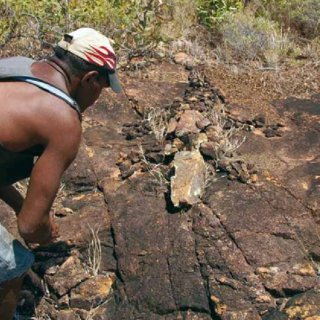
4. Hyde Park Barracks, Sydney, NSW
Hyde Park Barracks is part of a collection of colonial heritage structures in Australia, relating to Australia’s time as a penal settlement. Hyde Park Barracks in particular were the location of the housing of convict men from 1819 to 1830, with the 1830s to 1840s also involving the site being a location of additional convict punishment, and the base for the Board of Assignment of Servants. Following on from a reduction of convicts to NSW in the 1840s, the Barracks became the Female Immigration Depot, and the Orphan Institution, later becoming the Asylum for Infirm and Destitute Women.
This time period of women’s occupation provides some of the most interesting archaeological remains, as redevelopment and management of the site has found high rates of preservation within walls, and in areas below floorboards. This includes textiles and fabrics, papers, and other non-organic materials such as pipes (with their tobacco intact) stashed in what was once floor, wall, and ceiling cavities. Archaeological investigations in the area form one of the most detailed assemblages of artefacts relating to instituted women in the British Empire during the 19th century.



5. Notch Point, Western Australia (Multicultural heritage)
Notch Point is a site of varied and mixed archaeology, ranging from pre- and post- colonial period Aboriginal heritage, to diverse 19th century occupation of the region by Chinese, European, Malay, and Aboriginal peoples in association with pearling industries off the coast. In addition to this, the point is located on Dirk Hartog Island (otherwise known as Wirruwana), the site of the earliest European arrival in Western Australia in 1616, and contains archaeological evidence of both various early Dutch interactions with the island in 1616 and 1697, as well as French arrival in 1772, 1801, and 1818. Notch Point in particular also contains evidence of conflict between the predominantly Chinese population of the pearling industry, with white-Australian and European pearling masters, and pastoral agents. Its not a site that is widely discussed, but provides a fascinating overlay of the amount of varied cultural groups that can be present within Australia’s archaeological sites.

-
-
Honourable mentions to:
Lake Mungo and the Willandra Lakes which should 100% be on this list, but also I feel like I talk about it ALL the time and I wanted to mention sites that I actually don’t see discussed a lot. Theyre super important for cultural reasons, for archaeological reasons, and also for their role the development of archaeology, Aboriginal community consultation, and the role its played in developing repatriation practices in modern Australia. I have multiple posts about them HERE
Budj Bin Eel Traps in Victoria (same reasons, I’ve definitely talked about them before).
Juukan Gorge (and its destruction, im still horrified)
Harrietville Chinese Mining Village
Strangway Strings and The Peake Afghan Cameleer sites
Recherche Bay in Tasmania, and its 1792 French settlement sites
Homebush Mill & Mission Hall in QLD and Beowa National Park sites containing South Sea Islander heritage
#I feel like this constitutes a solid answer#i had fun#and hopefully people learn new things about Australian archaeology#and its diversity#sorry this took literally forever to answer#i got sick for a bit#and then its going to chill in my queue for a couple of days#archaeology#Australia#aboriginal and torres strait islander peoples#they let a mouse do archaeology?#Mice answers things
73 notes
·
View notes
Text
as someone who was doing academic/professional research and applying to graduate school last year and is doing professional research and applying to graduate school this year the difference in how inaccessible research has become in just TWELVE MONTHS is STARK and so deeply felt. I am lucky enough to have someone’s institutional IDs but it’s insane how I needed that to write the most basic lit reviews/application materials when I spent the last ~5 years in a broke third world public university with almost no institutional access and managed just fine. the destruction and hobbling of sci-hub, libgen, internet archive, and other open source resources is nothing less than mass epistemic violence against global south students and it’s only going to compound every year as the materials these platforms have access to become increasingly dated.
#on academia#research#epistemic injustice#I started of my college career with my professors hand writing the link to libgen and sci-hub on the blackboard#I ended my academic career with my city’s high court essentially killing libgen#the decline has been exponential
33 notes
·
View notes
Text
"The Growing Dangers of the MAGA Movement"
A Growing Threat to American DemocracyIntroductionThe "Make America Great Again" (MAGA) movement, which coalesced around Donald Trump's 2016 presidential campaign and has persisted beyond his presidency, represents one of the most significant political and cultural forces in modern American history. What began as a catchy campaign slogan has evolved into a broad ideological movement with tens of millions of devoted adherents.
While supporters view it as a patriotic effort to restore traditional American values and strength, critics see the MAGA movement as an existential threat to democracy, pluralism, and the rule of law in the United States. This essay will examine the origins and evolution of the MAGA movement, analyze its core ideological tenets and tactics, and explore the various ways in which it poses growing dangers to American democratic institutions and social cohesion.
By synthesizing research, expert analysis, and recent events, we can better understand the nature of this movement and the challenges it presents.
Origins and Evolution of the MAGA Movement
The roots of the MAGA movement can be traced back to long-standing currents of populism, nativism, and anti-establishment sentiment in American politics. However, it was Donald Trump who managed to coalesce these disparate threads into a potent political force during his 2016 presidential campaign. Trump's promise to "Make America Great Again" resonated with millions of Americans who felt left behind by globalization, demographic changes, and shifting cultural norms.
His brash, outsider persona and willingness to buck political correctness attracted those who were disillusioned with conventional politicians. Trump tapped into feelings of economic anxiety, cultural displacement, and resentment toward coastal elites to build a devoted base of support.
After his surprise victory in 2016, the MAGA slogan transformed from a campaign catchphrase into a full-fledged movement and identity. Trump supporters eagerly adopted the MAGA label, proudly wearing red hats and using the hashtag online. The movement took on a life of its own, with Trump as its figurehead but extending well beyond just one man.
Throughout Trump's presidency, the MAGA movement continued to evolve and radicalize. As Trump faced investigations, impeachment proceedings, and constant media scrutiny, his base became increasingly defensive and hostile toward perceived enemies.
Conspiracy theories like QAnon found fertile ground among MAGA adherents. The movement adopted an increasingly apocalyptic and militant tone, portraying itself as the last line of defense against sinister forces trying to destroy America.
The movement reached a crescendo - and a dangerous breaking point - on January 6, 2021, when thousands of Trump supporters violently stormed the U.S. Capitol in an attempt to overturn the results of the 2020 election. This event crystallized the growing extremism within the MAGA movement and its willingness to subvert democratic processes. Even after Trump left office, the MAGA movement has endured as a powerful force in American politics. It has reshaped the Republican Party in Trump's image and continues to exert enormous influence through primaries, fundraising, and setting the terms of political debate on the right.
Core Tenets and Ideology
While the MAGA movement encompasses a range of views, several core ideological tenets have emerged as central to its worldview:
America First Nationalism: The movement advocates an "America First" foreign and economic policy, rejecting globalism in favor of national sovereignty and protectionism.
Anti-immigration: Restricting both legal and illegal immigration is a top priority, often couched in nativist rhetoric about preserving American culture.
Cultural traditionalism: MAGA adherents push back against progressive social changes, championing traditional gender roles, religious values, and a nostalgic view of America's past.
Deep state paranoia: The movement is deeply distrustful of government institutions, mainstream media, and other power centers, believing them to be corrupt and working against the interests of everyday Americans.
Cult of personality: Loyalty to Donald Trump personally is a defining feature, with the movement portraying him as a messianic figure fighting dark forces.
Anti-"wokeness": The MAGA movement positions itself in staunch opposition to progressive ideas about systemic racism, LGBTQ+ rights, and other social justice causes.
Election denialism: Following Trump's lead, much of the movement refuses to accept the legitimacy of the 2020 election results, pushing baseless fraud claims.
Conspiratorial thinking: The movement is prone to embracing and amplifying conspiracy theories that support its worldview, from QAnon to COVID-19 misinformation.
These ideological pillars form the foundation of the MAGA movement's grievance-fueled politics and its antagonistic stance toward democratic institutions and norms.
Tactics and Strategies
The MAGA movement employs a range of tactics to advance its goals and expand its influence:
Social media mobilization: Savvy use of platforms like Twitter, Facebook, and newer alt-tech sites allows rapid dissemination of messaging and coordination of grassroots action.
Alternative media ecosystem: A network of right-wing news outlets, podcasts, and influencers creates an insular information bubble for supporters.
Intimidation and threats: Movement figures often use violent rhetoric and veiled threats to intimidate opponents and critics.
Litigation and legal challenges: An army of pro-Trump lawyers file dubious lawsuits to challenge election results and other perceived slights.
Primary challenges: The movement targets "disloyal" Republicans with primary opponents to enforce ideological conformity.
Propaganda and disinformation: Coordinated campaigns spread misleading narratives and outright falsehoods to shape public opinion.
Protests and rallies: Mass gatherings serve to energize the base and project a show of force.
Infiltration of local offices: The movement has pushed supporters to take over low-level government positions like election boards and school boards.
These tactics have proven effective at solidifying the movement's power within the Republican Party and exerting outsized influence on the national political conversation.Growing Dangers to DemocracyThe MAGA movement poses several interconnected threats to the stability and functioning of American democracy:
Undermining faith in elections
Perhaps the most immediate danger is the movement's persistent efforts to cast doubt on the integrity of U.S. elections. By pushing baseless claims of widespread voter fraud and refusing to accept unfavorable results, MAGA leaders are actively eroding public trust in the democratic process.This delegitimization of elections has several alarming consequences. It provides justification for new voting restrictions that disproportionately impact minority communities. It increases the risk of political violence, as we saw on January 6th when MAGA supporters felt empowered to use force to "stop the steal." And it creates a permission structure for future attempts to overturn legitimate election results.If a large segment of the population no longer believes in the basic mechanics of democracy, it becomes nearly impossible to have peaceful transfers of power or to solve problems through normal political channels.
2.Assault on the rule of law
The MAGA movement has shown a troubling willingness to disregard the rule of law when it conflicts with their goals. This manifests in several ways:
Refusing to comply with lawful subpoenas and oversight efforts
Pardoning political allies convicted of crimes
Interfering in ongoing investigations for political purposes
Calling for the imprisonment of political opponents without due process
Flouting ethics rules and profiting from public office
By treating the law as optional or applicable only to their enemies, MAGA leaders set a dangerous precedent that threatens the foundations of constitutional governance.
3.Embracing political violence
While not universal among supporters, there is a strong current of militancy within the MAGA movement that views violence as a legitimate political tool. This mindset has led to increased threats against public officials, journalists, and even fellow Republicans deemed insufficiently loyal.The events of January 6th represented a shocking escalation, demonstrating that a significant portion of the movement is willing to use force to achieve its ends. Even more concerning is the way many MAGA leaders have subsequently downplayed or justified the Capitol attack.This normalization of political violence profoundly destabilizes democracy and makes peaceful resolution of differences far more difficult
4.Undermining truth and shared reality
The MAGA movement's loose relationship with factual reality represents another serious threat to functional democracy. By embracing conspiracy theories, rejecting scientific expertise, and creating alternative information ecosystems, the movement erodes the possibility of having good-faith debates based on a shared set of facts.When a large segment of the population lives in a completely different epistemic reality, it becomes nearly impossible to find common ground or craft effective policy solutions. This rejection of truth and expertise also leaves followers vulnerable to manipulation and extreme ideas.
5.Weakening of democratic institutions
MAGA leaders have waged a sustained assault on the legitimacy of key democratic institutions like the justice system, intelligence agencies, the press, and career civil servants. By portraying these entities as part of a nefarious "deep state" working against the people, the movement weakens public trust in the very institutions needed for democracy to function.This institutional erosion creates a vicious cycle, as weakened institutions are less able to serve as a check on abuses of power, leading to further deterioration.6.
Personality cult dynamics
The MAGA movement's intense devotion to Donald Trump personally introduces instability and irrationality into the political system. When loyalty to an individual trumps commitment to principles or the national interest, it opens the door to significant abuses of power.The personalization of politics around Trump also makes it more difficult to resolve political differences through normal democratic means. Policy debates get reduced to whether one supports or opposes Trump as an individual.
7.Minority rule tendencies
There are strong anti-democratic currents within the MAGA movement that seek to entrench minority rule through a variety of mechanisms:
Extreme gerrymandering
Voter suppression targeting Democratic-leaning groups
Exploiting the electoral college and Senate's rural bias
Court packing to lock in a conservative judiciary
Calls to repeal the 17th Amendment (direct election of Senators)
These efforts to insulate MAGA power from the will of the majority represent a fundamental threat to the principle of popular sovereignty.
8.Scapegoating and demonitiization
The MAGA movement's rhetoric often seeks to divide Americans into "real" patriots versus dangerous "others" - whether immigrants, racial minorities, liberals, or the nebulous "elite." This deliberate "us vs. them" framing corrodes social cohesion and paints political opponents as existential enemies rather than fellow citizens with differing views.Taken to extremes, this dehumanization of the opposition can be used to justify anti-democratic actions or even violence in the name of defending the "real America.
Potential Future Trajectories
Looking ahead, there are several potential paths the MAGA movement could take, each with significant implications for American democracy:
Moderation and reintegration: In this optimistic scenario, the movement gradually moderates its views and tactics, allowing for its reintegration into normal democratic politics. This would likely require new leadership and a rejection of its most extreme elements.
Continued radicalization: The movement could continue down the path of escalating extremism, embracing more conspiratorial thinking and explicit calls for anti-democratic action. This risks further political violence and democratic backsliding.
Splintering: Internal divisions could cause the movement to fragment into competing factions, potentially diminishing its overall influence but also creating space for even more radical offshoots.
Institutional capture: The movement could succeed in taking over the Republican Party entirely and gaining control of key government institutions, allowing for the implementation of its agenda through official channels.
Authoritarian takeover: In a worst-case scenario, MAGA leaders could leverage a crisis or electoral victory to rapidly dismantle democratic guardrails and institute authoritarian rule, similar to what has occurred in countries like Hungary.
The trajectory the movement takes will depend on a variety of factors, including the actions of MAGA leaders, the response of democratic institutions, economic conditions, and unforeseen events that could reshape the political landscape. Responding to the Threat Given the serious dangers posed by the MAGA movement, a robust democratic response is necessary. Some potential strategies include:
Strengthening democratic institutions: Shoring up the integrity and independence of bodies like the Justice Department, election administration, and civil service to withstand political pressure.
Civic education: Improving public understanding of democratic processes and values to build resilience against anti-democratic messaging.
Media literacy: Equipping citizens with the tools to critically evaluate information sources and resist disinformation.
Bipartisan coalition building: Forging alliances between Democrats and non-MAGA Republicans to present a united front in defense of democratic norms.
Economic policy: Addressing the legitimate economic grievances that fuel support for the movement through inclusive growth policies.
Legal accountability: Ensuring that violations of law and democratic norms face appropriate consequences, regardless of political affiliation.
Depolarization efforts: Investing in initiatives that bridge partisan divides and rebuild social cohesion at the community level.
Election reform: Implementing reforms to increase faith in election integrity while expanding access to voting.
Countering extremism: Providing off-ramps and support for those at risk of radicalization into anti-democratic ideologies.
Conclusion
The MAGA movement represents one of the most significant challenges to American democracy in generations. Its potent mix of grievance politics, personality cult dynamics, and anti-democratic tendencies poses a multifaceted threat to the stability and functioning of the country's political system.
While the movement taps into some legitimate frustrations with the status quo, its proposed solutions and tactics risk undermining the very foundations of constitutional governance. The normalization of political violence, erosion of truth, and delegitimization of democratic institutions create a volatile situation with the potential for severe instability.
Responding effectively to this threat will require a clear-eyed understanding of the movement's appeal and tactics, coupled with proactive efforts to strengthen democratic guardrails and rebuild civic cohesion. The future of American democracy may well hinge on the ability to successfully navigate this challenge in the years to come.
Ultimately, preserving a healthy democracy requires constant vigilance and renewal. The MAGA movement serves as a stark reminder that even long-established democracies are not immune to authoritarian impulses. By understanding the nature of this threat, Americans across the political spectrum can work to uphold the principles of democratic self-governance for future generations.
#politics#donald trump#joe biden#potus#scotus#heritage foundation#trump#democracy#democrats#maga#maga morons#maga cult#make america great again
28 notes
·
View notes
Text
The Collective Intelligence Institute

History is written by the winners, which is why Luddite is a slur meaning “technophobe” and not a badge of honor meaning, “Person who goes beyond asking what technology does, to asking who it does it for and who it does it to.”
https://locusmag.com/2022/01/cory-doctorow-science-fiction-is-a-luddite-literature/
If you’d like an essay-formatted version of this post to read or share, here’s a link to it on pluralistic.net, my surveillance-free, ad-free, tracker-free blog:
https://pluralistic.net/2023/02/07/full-stack-luddites/#subsidiarity
Luddites weren’t anti-machine activists, they were pro-worker advocates, who believed that the spoils of automation shouldn’t automatically be allocated to the bosses who skimmed the profits from their labor and spent them on machines that put them out of a job. There is no empirical right answer about who should benefit from automation, only social contestation, which includes all the things that desperate people whose access to food, shelter and comfort are threatened might do, such as smashing looms and torching factories.
The question of who should benefit from automation is always urgent, and it’s also always up for grabs. Automation can deepen and reinforce unfair arrangements, or it can upend them. No one came off a mountain with two stone tablets reading “Thy machines shall condemn labor to the scrapheap of the history while capital amasses more wealth and power.” We get to choose.
Capital’s greatest weapon in this battle is inevitabilism, sometimes called “capitalist realism,” summed up with Frederic Jameson’s famous quote “It’s easier to imagine the end of the world than the end of capitalism” (often misattributed to Žižek). A simpler formulation can be found in the doctrine of Margaret Thatcher: “There Is No Alternative,” or even Dante’s “Abandon hope all ye who enter here.”
Hope — alternatives — lies in reviving our structural imagination, thinking through other ways of managing our collective future. Last May, Wired published a brilliant article that did just that, by Divya Siddarth, Danielle Allen and E. Glen Weyl:
https://www.wired.com/story/web3-blockchain-decentralization-governance/
That article, “The Web3 Decentralization Debate Is Focused on the Wrong Question,” set forth a taxonomy of decentralization, exploring ways that power could be distributed, checked, and shared. It went beyond blockchains and hyperspeculative, Ponzi-prone “mechanism design,” prompting me to subtitle my analysis “Not all who decentralize are bros”:
https://pluralistic.net/2022/05/12/crypto-means-cryptography/#p2p-rides-again
That article was just one installment in a long, ongoing project by the authors. Now, Siddarth has teamed up with Saffron Huang to launch the Collective Intelligence project, “an incubator for new governance models for transformative technology.”
https://cip.org/whitepaper
The Collective Intelligence Project’s research focus is “collective intelligence capabilities: decision-making technologies, processes, and institutions that expand a group’s capacity to construct and cooperate towards shared goals.” That is, asking more than how automation works, but who it should work for.
Collective Intelligence institutions include “markets…nation-state democracy…global governance institutions and transnational corporations, standards-setting organizations and judicial courts, the decision structures of universities, startups, and nonprofits.” All of these institutions let two or more people collaborate, which is to say, it lets us do superhuman things — things that transcend the limitations of the lone individual.
Our institutions are failing us. Confidence in democracy is in decline, and democratic states have failed to coordinate to solve urgent crises, like the climate emergency. Markets are also failing us, “flatten[ing] complex values in favor of over-optimizing for cost, profit, or share price.”
Neither traditional voting systems nor speculative markets are up to the task of steering our emerging, transformative technologies — neither machine learning, nor bioengineering, nor labor automation. Hence the mission of CIP: “Humans created our current CI systems to help achieve collective goals. We can remake them.”
The plan to do this is in two phases:
Value elicitation: “ways to develop scalable processes for surfacing and combining group beliefs, goals, values, and preferences.” Think of tools like Pol.is, which Taiwan uses to identify ideas that have the broadest consensus, not just the most active engagement.
Remake technology institutions: “technology development beyond the existing options of non-profit, VC-funded startup, or academic project.” Practically, that’s developing tools and models for “decentralized governance and metagovernance, internet standards-setting,” and consortia.
The founders pose this as a solution to “The Transformative Technology Trilemma” — that is, the supposed need to trade off between participation, progress and safety.
This trilemma usually yields one of three unsatisfactory outcomes:
Capitalist Acceleration: “Sacrificing safety for progress while maintaining basic participation.” Think of private-sector geoengineering, CRISPR experimentation, or deployment of machine learning tools. AKA “bro shit.”
Authoritarian Technocracy: “Sacrificing participation for progress while maintaining basic safety.” Think of the vulnerable world hypothesis weirdos who advocate for universal, total surveillance to prevent “runaway AI,” or, of course, the Chinese technocratic system.
Shared Stagnation: “Sacrificing progress for participation while maintaining basic safety.” A drive for local control above transnational coordination, unwarranted skepticism of useful technologies (AKA “What the Luddites are unfairly accused of”).
The Institute’s goal is to chart a fourth path, which seeks out the best parts of all three outcomes, while leaving behind their flaws. This includes deliberative democracy tools like sortition and assemblies, backed by transparent machine learning tools that help surface broadly held views from within a community, not just the views held by the loudest participants.
This dovetails into creating new tech development institutions to replace the default, venture-backed startup for “societally-consequential, infrastructural projects,” including public benefit companies, focused research organizations, perpetual purpose trusts, co-ops, etc.
It’s a view I find compelling, personally, enough so that I have joined the organization as a volunteer advisor.
This vision resembles the watershed groups in Ruthanna Emrys’s spectacular “Half-Built Garden,” which was one of the most inspiring novels I read last year (a far better source of stfnal inspo than the technocratic fantasies of the “Golden Age”):
https://pluralistic.net/2022/07/26/aislands/#dead-ringers
And it revives the long-dormant, utterly necessary spirit of the Luddites, which you can learn a lot more about in Brian Merchant’s forthcoming, magesterial “Blood In the Machine: The Origins of the Rebellion Against Big Tech”:
https://www.littlebrown.com/titles/brian-merchant/blood-in-the-machine/9780316487740/
This week (Feb 8–17), I’ll be in Australia, touring my book Chokepoint Capitalism with my co-author, Rebecca Giblin. We’ll be in Brisbane tomorrow (Feb 8), and then we’re doing a remote event for NZ on Feb 9. Next are Melbourne, Sydney and Canberra. I hope to see you!
[Image ID: An old Ace Double paperback. The cover illustration has been replaced with an 18th century illustration depicting a giant Ned Ludd leading an army of Luddites who have just torched a factory. The cover text reads: 'The Luddites. Smashing looms was their tactic, not their goal.']
#pluralistic#ai#artificial intelligence#b-corps#collective intelligence#full-stack luddism#full-stack luddites#governance#luddism#ml#sortition#subsidiarity
619 notes
·
View notes
Text
The new global study, in partnership with The Upwork Research Institute, interviewed 2,500 global C-suite executives, full-time employees and freelancers. Results show that the optimistic expectations about AI's impact are not aligning with the reality faced by many employees. The study identifies a disconnect between the high expectations of managers and the actual experiences of employees using AI. Despite 96% of C-suite executives expecting AI to boost productivity, the study reveals that, 77% of employees using AI say it has added to their workload and created challenges in achieving the expected productivity gains. Not only is AI increasing the workloads of full-time employees, it’s hampering productivity and contributing to employee burnout. To add insult to injury, nearly half (47%) of employees using AI say they don’t know how to achieve the expected productivity gains their employers expect, and 40% feel their company is asking too much of them when it comes to AI. Workers are feeling the strain from rising productivity demands, with one in three full-time employees saying they will likely quit their jobs in the next six months due to feeling overworked and burnt out. The majority of global C-suite leaders (81%) acknowledge they have increased demands on their workers in the past year. Consequently, 71% of full-time employees are burned out, and 65% report struggling with their employer’s demands on their productivity.
Archived from Forbes.
23 July 2024
208 notes
·
View notes
Text
Also preserved in our archive
Another great reason to keep masking: We don't even have a good treatment for long covid yet, and many doctors know simply nothing about the condition.
Global efforts to understand and manage long Covid post-pandemic, with varied symptoms and limited treatment guidelines worldwide
Doctors in India are grappling to diagnose and treat unexplained and persistent symptoms of long Covid patients due to limited guidelines, whereas researchers have flagged inadequate studies on the condition.
With the World Health Organization declaring an end to COVID-19 as a global health emergency in May last year, focused efforts are underway around the world to estimate the burden of long Covid among the population.
The condition refers to the set of lingering symptoms affecting varied body parts and persisting well beyond the acute Covid infection period, including cough, muscle and joint pain, fatigue, brain fog and difficulty in focusing. The viral disease is caused by the SARS-CoV-2 virus.
While studies have suggested that about a third of those moderately or severely infected are likely to suffer from long Covid, region-wise though, incidence could vary.
A study by researchers, including those from Harvard Medical School, U.S., estimated that 31% of the once-infected people in North America, 44% in Europe, and 51% in Asia, have long Covid, which is “challenging the healthcare system, but there are limited guidelines for its treatment”. It was published in the International Journal of Infectious Diseases in September.
In India, however, studies on long Covid are few and far between.
One such study by Maulana Azad Medical College in New Delhi, conducted from May 2022 to March 2023 on 553 patients who had recovered from Covid, found that about 45% had lingering symptoms, persistent fatigue and dry cough being the most common.
“There is limited exploratory research on the long Covid syndrome with scarce data on long-term outcomes,” the authors wrote in the study published in the journal Cureus in May this year.
Understanding the long-term effects of the virus is important for developing management strategies, optimising healthcare delivery, and providing support to recovered Covid patients in the community, they said.
Dr Rajesh Sagar, Professor of Psychiatry, All India Institute of Medical Sciences (AIIMS), New Delhi, said, “Looking at the current state of long Covid studies in India, it is too premature to say that we understand the condition well enough to know how to diagnose or treat it.”
Animesh Samanta, assistant professor at School of Natural Sciences in Shiv Nadar University, Greater Noida, said, “While studies in India highlight the growing recognition of neurological complications in long Covid patients, more focused research on neuroinflammation is needed.”
Doctors, too, have reported a rise in patients complaining of symptoms that they did not have pre-Covid. “People who never had asthma in the past, post-Covid, with every viral infection, they get a long cough, shortness of breath and wheezing, which require the use of inhalers or nebuliser,” senior consultant Dr. Neetu Jain, who runs a post-Covid care clinic at Pushpawati Singhania Hospital and Research Institute, New Delhi, said.
Dr. Arun Garg, chairman, Neurology and Neurosciences, Medanta-The Medicity, Gurugram, said that he was noticing a spike in stroke cases among young patients not suffering from known risk factors such as diabetes, hypertension and obesity.
“Similarly, we are seeing more cases of encephalopathy (swelling of the brain) without reason and having a confused state of mind following one or two days of fever. Their MRI scans show no changes. These patients have increased significantly after Covid,” he said.
In the absence of medical guidelines to diagnose long Covid, doctors are having to resort to broad, non-specific tests and questionnaires to gauge a patient’s ‘quality of life’.
Studies have shown that the fatigue experienced in long Covid is similar to that in cancer patients, with a quality of life similar to patients of Parkinson’s disease.
“We really do not have any test to diagnose long Covid, even though it is definitely a clinical diagnosis. We diagnose long Covid for people who had at least moderate to severe infection, following which they could never regain the quality-of-life pre-Covid. Checking for inflammatory markers like C-reactive proteins (CRP) can support the diagnosis,” Dr. Jain said.
“Other than routine blood tests that measure inflammation, we do antibody tests to look for direct markers. In many of these patients, we are finding rare antibodies which are very new to us and were not there pre-Covid,” Dr. Garg said.
Inflammation persisting despite recovery from acute Covid infection is thought to lie at the heart of long Covid. However, tests to measure this specific immune response are lacking, even as researchers have been working in this direction worldwide.
One such effort comes from Shiv Nadar University, where a team led by Mr. Samanta has developed a fluorescent probe capable of detecting inflammation in brain cells that can arise due to Covid infection.
The probe measures nitric oxide levels in brain cells, especially in human microglia cells, where increased NO levels are linked to the SARS-CoV-2 infection. Microglia are immune cells in the brain that fight disease and help maintain brain health.
Lysosomes within microglia, which help clear foreign disease-causing agents like the SARS-CoV-2 virus, produce nitric oxide as part of an immune response to infection. The probe detects nitric oxide produced in lysosomes in response to infection and thereby allows for a measurement of inflammation levels.
This examination method can provide “qualitative information on infection status”, said Mr. Samanta, corresponding author on the study published in the journal Analytical Chemistry in American Chemical Society.
He explained that patients with pre-existing conditions such as Alzheimer’s disease, Parkinson’s disease or multiple sclerosis (an autoimmune disorder) could exhibit prolonged neuroinflammation and loss of brain cells following Covid infection.
While the probe has shown efficacy in cell cultures, animal studies would need to be done, before testing it in humans, Mr. Samanta said.
Looking at the World Health Organization International Clinical Trials Registry Platform, the study by Harvard Medical School had found that 587 clinical studies were conducted on long Covid, of which about 53% (312) were testing potential treatments.
Most of these were found to be conducted in the U.S. (58), followed by India (55) and Spain (20). The trials looked at interventions including physical exercise, psychotherapy, and pharmacological ones such as paxlovid and fluvoxamine.
However, “to date, only 11 of these 312 studies have published their results that were not confirmative,” the researchers wrote.
The team called for studies to look into sleep disorders which were rarely included in the registered clinical studies. Further, interventions targeting the biological processes responsible for long Covid are needed but currently lacking, they said.
#mask up#covid#pandemic#public health#wear a mask#covid 19#wear a respirator#still coviding#coronavirus#sars cov 2#long covid#india
12 notes
·
View notes
Text
Story Preview: Magic/Dark Academia AU in which skating, linguistics, and time travel intersect
Professor Baranovskaya loudly cleared her throat and placed a hand on Yuuri’s trembling shoulder.
“Everyone, please take a moment to welcome your newest classmate,” she airily announced, to a rather stilted round of clapping. “If you didn’t get a chance to meet him at the Prospective Students Banquet last December– ” (to Viktor’s chagrin, even louder giggling erupted, making him want to throttle Isabella Yang) “ – or over the last few weeks, allow me to introduce first year student Katsuki Yuuri, hailing from the town of Hasetsu, Japan. I’m told by Professor Cialdini that Yuuri’s grasp of Reverberatory Theory could rival a faculty member’s, so I’m sure you’ll find him to be a valuable resource.”
Curious whispers filled the room at this last sentence. Aside from Viktor and just two other students – 4th years Sasha Samokhina and Kostya Kozhennikov – no one else had actually managed to grasp the intricacies of Reverberation, particularly when it came to its grammatical rules.
“That being said, do try not to resent his prowess too much,” Professor Baranovskaya firmly finished.
Their eyes met and Viktor felt a bit insulted by her lingering gaze. Resent Yuuri?
Him?!?
Once again, Viktor reflected on how misunderstood he was at Pax. If he tried to befriend promising students like Sasha or his fellow dual major classmate Nao Yasutani, it was automatically regarded with skepticism, as if the Institute's top Reverberator couldn’t possibly want companionship without having ulterior motives.
It made him want to scream.
Had Professor Baranovskaya forgotten how he’d begged Drs. Piseev and Leroy to accompany them on the scouting trip to Japan, back in April? Had she conveniently forgotten that it was Viktor who had so zealously insisted on Yuuri’s recruitment to Pax in the first place, well before that wondrous video had been uploaded to the internet?
---
The above excerpt is a preview of a new 'Alternate First Meeting' Yuri!!! on Ice WIP/series I'm working on: a friends-to-lovers, magical dark academia AU that I was inspired to write after finishing the books Vita Nostra (by Maryna and Serhiy Dyachenko), and Babel (by RF Kuang). Both are so gripping and imaginative, and I couldn't stop thinking about how my favorite characters might intersect with the rich settings/magic systems in either.
Below is a tentative summary; if this sounds interesting, I hope you'll give me a follow!
---
The first known instance of Reverberation – the phenomenon in which a skater produces language and energy with their body, universally felt and understood by all in proximity – occurred in 1952, when Dick Button performed the first triple jump. Over 50 years later, Viktor Nikiforov is skating’s most prolific Reverberator and star student at the University of Chicago’s Pax Institute: the world’s premier research center dedicated to the training of Reverberators for global diplomacy.
When Katsuki Yuuri finds himself being aggressively recruited by his idol to enroll at Pax, he has no idea that the two of them will eventually become best friends. Or, that they will one day co-lead a student uprising once they uncover the true, sinister aim of their education: to master the art of stationary Reverberation that transfers language onto blank pages and creates enough energy to rip through time
#yuri on ice#yuri!!! on ice#yuri on ice fanfiction#yoi fanfiction#my writing#my wips#Vita Nostra/Babel AU#vita nostra#babel an arcane history#viktuuri#victuuri#yuri on ice au#yes I am once again overcommitting#the hyperfixations are multiplying#this is why I shouldn't read
10 notes
·
View notes
Text
Wheat on repeat (Anthropocene Magazine)
Excerpt from this story from Anthropocene Magazine:
Disguised within an ordinary-looking bowl of pasta before me is a brand new ingredient, 20-years in the making, that many believe could single-handedly slash emissions, store carbon in the soil, and help the wider environment.
The neat fusilli coils contain flour ground from Kernza, a perennial wheat-like crop that produces multiple harvests from one plant, year after year after year. I received some cooking instructions to get the best out of the novel ingredient: “Don’t cover it up with a bunch of sauce! Make sure you can taste it,” says Lee DeHaan, a scientist at The Land Institute, a non-profit agriculture research organization based in Salina, Kansas, that developed the Kernza grain. I follow his guidance, drizzling in a little olive oil and a pinch of salt, and then take a bite, letting the pasta’s flavors emerge: a subtle but unmistakable hint of cinnamon, followed by nutmeg. It’s unexpectedly warm and earthy, like a salute to the rich Kansas soils that Kernza first sprouted from.
The way this crop was raised there was very different to its cousin, conventional wheat. Wheat is an annual crop, like rice and corn, which together account for almost half of the calories humanity consumes. Annuals must be planted and harvested anew each year, a system that requires farmers to heap fertilizers and herbicides onto the land, dispersed by gas-guzzling machinery that bloats agriculture’s carbon footprint. Meanwhile, repeated cycles of tilling and replanting strips the soil of nutrients, and loses vital topsoil to wind and rain. Over time, those soils may degrade, pushing farmers onto new land in search of fertile ground.
Each mouthful of this Kernza-rich pasta, on the other hand, supports farming that locks topsoil in place and stores carbon in the earth. A growing movement of researchers, farmers, and producers believe that perennial crops have unmatched potential to reform agriculture’s warped system, and are pinning their hopes—and research dollars—on the likes of Kernza to deliver that. The grain is now cultivated across 4,000 acres of land, by over 100 farmers across the US Midwest and as far afield as Sweden and France. Its distinct aromas have made their way into craft beers, cereals, crackers, and whiskey, and have been embraced by major brands such as Patagonia.
As a potential substitute for wheat, which covers more global land area than any other commercial crop, Kernza seems to herald a wholesome, low-carbon revolution in the vast agricultural sector. And yet 15 years since the first stands took root, the crop has only managed to capture a tiny fraction of the market, a victim of limited yields, government regulation, and a conservative farming industry. So can Kernza ever displace traditional amber waves of grain, or is it doomed to be a perennial runner-up?
12 notes
·
View notes
Text
Free tactical medicine learning resources
If you want to learn first aid, emergency care or tactical medical care for real, you will need to practice these skills. A lot. Regularly. There’s no way to learn them just from books. But if you’re looking to supplement your training, can’t access hands on training, are a layperson doing research for your writing or otherwise just curious, here are some free resources (some may need a free account to access them).
TCCC
The current gold standard in the field is Tactical Combat Casualty Care (TCCC), developed by the US army but used by militaries around the world. There is also a civilian version of the system called Tactical Emergency Casualty Care (TECC). Training materials, Standards of Care, instructional videos, etc. can be accessed at deployedmedicine.com. You’ll need a free account. This should be your first and possibly only stop.
There’s also an app and a podcast if those are more your thing, although I haven’t personally tried them.
More TCCC (video) resources
STOP THE BLEED® Interactive Course
TCCC-MP Guidelines and Curriculum presentations and training videos
EURMED’s Medical Beginner's Resource List has suggested list of video materials (disclaimer: I haven’t watched the playlists, but I have been trained by nearly all of the linked systems/organisations and can vouch for them)
Tactical Medical Solutions training resource page (requires registration; some of the courses are free)
North American Rescue video downloads
Emergency medicine
WHO-ICRC Basic Emergency Care: approach to the acutely ill and injured — an open-access course workbook for basic emergency care with limited resources
Global Health Emergency Medicine — open-access, evidence-based, peer-reviewed emergency medicine modules designed for teachers and learners in low-resource health setting
AFEM Resources — curricula, lecture bank, reviews, etc.
Global Emergency Medicine Academy Resources (links to more resources)
OpenStax Anatomy and Physiology textbook
Open-access anatomy and physiology learning resources
OpenStax Pharmacology for nurses textbook
Principles of Pharmacology – Study Guide
Multiple Casualty Incidents
Management of Multiple Casualty Incidents lecture
Bombings: Injury Patterns and Care blast injuries course (scroll down on the page)
Borden Institute has medical textbooks about biological, chemical and nuclear threats
Psychological first aid: Guide for field workers
Prolonged field care
When the evac isn’t coming anytime soon.
Prolonged Field Care Basics lecture (requires registration)
Aerie 14th Edition Wilderness Medicine Manual (textbook)
Austere Emergency Medical Support (AEMS) Field Guide (textbook)
Prolonged Casualty Care (PCC) Guidelines
Wilderness Medical Society Clinical Practice Guidelines
Austere Medicine Resources: Practice Guidelines — a great resource of WMS, PFC, TCCC, etc. clinical practice guidelines in one place
The Wilderness and Environmental Medicine Journal (you can read past issues without a membership)
Prolonged Field Care Collective: Resources
National Park Services Emergency Medical Services Resources
Guerilla Medicine: An Introduction to the Concepts of Austere Medicine in Asymmetric Conflicts (article)
Mental health & PTSD
National Center for PTSD
Psychological first aid: Guide for field workers
Combat and Operational Behavioral Health (medical textbook)
Resources for doctors and medical students
Or you know, other curious people who aren’t afraid of medical jargon.
Borden Institute Military Medical Textbooks and Resources — suggestions: start with Fundamentals of Military Medicine; mechanism of injury of conventional weapons; these two volumes on medical aspects of operating in extreme environments; psychosocial aspects of military medicine; or Combat Anesthesia
Emergency War Surgery textbook and lectures
Disaster Health Core Curriculum — online course for health professionals
Médecins Sans Frontières Clinical guidelines
Pocket book of hospital care for children: Second edition — guidelines for the management of common childhood illnesses in low resource settings
Grey’s Quick Reference: Basic Protocols in Paediatrics and Internal Medicine For Resource Limited Settings
The Department of Defense Center of Excellence for Trauma: Trauma Care Resources (links to more resources)
#feel free to share and add more#tactical medicine#tactical combat casualty care#prolonged field care#austere medicine#military medicine#tccc#tecc#disaster medicine#wilderness medicine#emergency medicine#emergency medical services#learning resources#writing resources#mandalorian medics#paramedicine#medicine
33 notes
·
View notes
Text
Good News - May 8-14
Like these weekly compilations? Support me on Ko-fi! Also, if you tip me on Ko-fi, at the end of the month I'll send you a link to all of the articles I found but didn't use each week - almost double the content!
1. Critically endangered fish with red hands and 'sad toad face' returned to the wild in Tasmania

“Conservationists in Australia are celebrating the return of 18 critically endangered red handfish to the sea after they were taken into care at the Institute for Marine and Antarctic Studies (IMAS) in January to protect them from marine heatwaves.”
2. A rare Australian marsupial is being genetically modified to save it from extinction. Here's how

“Scientists are trying to genetically 'edit' the endangered northern quoll to make it resistant to the neurotoxin of the invasive cane toad. […] Now experts in gene-editing […] say they can introduce genetic resistance to the toxin by taking DNA from a species of South American lizard and ‘edit’ that into the cells of a northern quoll. They have already managed to do this with the cells of the closely related dunnart, another endemic marsupial.”
3. More and faster: Electricity from clean sources reaches 30% of global total

“For the first time, 30% of electricity produced worldwide was from clean energy sources as the number of solar and wind farms continued to grow fast. [...] Some of [the past year’s] new demand was for heat pumps, which are an efficient way to both heat and cool buildings, and for electric vehicles. [... Last year was also] the 19th year in a row that solar was the fastest-growing source of electricity generation.”
4. Standards Established To Improve Health Care For Kids With Disabilities
“Developed by a panel of health care experts, adults with disabilities and caregivers, the plan published recently in the journal Pediatrics […] calls for providers to be trained about caring for those with neurodevelopmental disabilities, improved communication with patients and their families and proactive planning in advance of health care encounters to ensure that patients are at ease and provided accommodations.”
5. Working together to better understand Alaska’s beluga whales

“Beluga conservation efforts depend on an accurate count of whales. Indigenous hunters also need to know how many belugas there are so that they [can] decide how many can be safely harvested. That’s why WWF is bringing together Western science and Indigenous knowledge […. U]sing hydrophones to detect belugas in the Yukon River works—and it is an approach that is both cost-effective and non-invasive.”
6. Robotic system feeds people with severe mobility limitations
“Researchers have developed a robotic feeding system that uses computer vision, machine learning and multimodal sensing to safely feed people with severe mobility limitations, including those with spinal cord injuries, cerebral palsy and multiple sclerosis. […] The robotic system successfully fed 13 individuals with diverse medical conditions in a user study spanning three locations[….] Users of the robot found it to be safe and comfortable, researchers said.”
7. Senate Passage of America’s Conservation Enhancement Act a Win for Wildlife

“The Senate’s reauthorization of the America’s Conservation Enhancement (ACE) Act will benefit America’s wildlife and way of life. Led by Senators Tom Carper (D-Del.) and Shelley Capito (R-W.Va.), the bill invests in wetlands and habitat restoration projects across the country as well as strategies to reduce conflicts between wildlife and livestock. […] The passage of this bill shows us once again that Americans are united on the need to protect wildlife and our outdoor heritage,” said Andrew Wilkins, director of land conservation policy at the National Wildlife Federation.”
8. Liberals and conservatives differ on climate change beliefs--but are relatively united in taking action
“The study, led by researchers at New York University, finds that when given the opportunity, liberals and conservatives take action to address climate change at roughly the same levels -- and that this is due to conservatives choosing to take action despite their climate-change beliefs rather than liberals failing to act on theirs.”
9. Democratic state attorneys general are teaming up to protect abortion access

“A group of Democratic attorneys general are working to strengthen state-level protections for abortion, contraception and gender-affirming care. These protections could include expanding the use of so-called “shield laws,” which assert that states where abortion or gender-affirming care are legal won’t cooperate with out-of-state efforts to prosecute anyone who helped provide treatment.”
10. Antwerp gives residents free trees

“The Belgian city of Antwerp has 2,000 trees to give away, and it wants to give them to residents to plant in their gardens [...] with the aim of involving citizens in the greenifying process of the city. [...] What’s more, the city website offers practical advice on how to proceed with planting and caring for the tree so that it will meet the standards set by the municipality. [...] The City makes sure to give dead trees a second life by using their wood in the making of natural kids’ playgrounds.”
May 1-7 news here | (all credit for images and written material can be found at the source linked; I don’t claim credit for anything but curating.)
#good news#hopepunk#fish#australia#endangered species#marsupial#gene editing#toad#electricity#clean energy#solar#solar energy#wind farm#wind energy#healthcare#disability#disabled#neurodivergent#alaska#alaska native#native#beluga#robots#wildlife#habitat restoration#politics#climate#climate change#abortion#abortion rights
18 notes
·
View notes
Text
The phone or computer you’re reading this on may not be long for this world. Maybe you’ll drop it in water, or your dog will make a chew toy of it, or it’ll reach obsolescence. If you can’t repair it and have to discard it, the device will become e-waste, joining an alarmingly large mountain of defunct TVs, refrigerators, washing machines, cameras, routers, electric toothbrushes, headphones. This is “electrical and electronic equipment,” aka EEE—anything with a plug or battery. It’s increasingly out of control.
As economies develop and the consumerist lifestyle spreads around the world, e-waste has turned into a full-blown environmental crisis. People living in high-income countries own, on average, 109 EEE devices per capita, while those in low-income nations have just four. A new UN report finds that in 2022, humanity churned out 137 billion pounds of e-waste—more than 17 pounds for every person on Earth—and recycled less than a quarter of it.
That also represents about $62 billion worth of recoverable materials, like iron, copper, and gold, hitting e-waste landfills each year. At this pace, e-waste will grow by 33 percent by 2030, while the recycling rate could decline to 20 percent. (You can see this growth in the graph below: purple is EEE on the market, black is e-waste, and green is what gets recycled.)
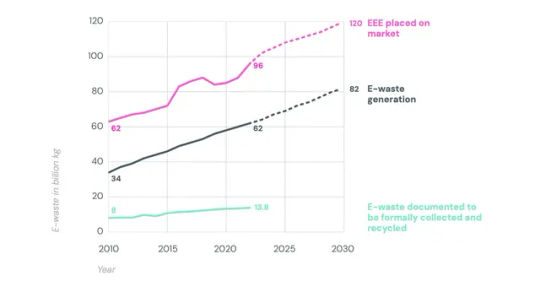
“What was really alarming to me is that the speed at which this is growing is much quicker than the speed that e-waste is properly collected and recycled,” says Kees Baldé, a senior scientific specialist at the United Nations Institute for Training and Research and lead author of the report. “We just consume way too much, and we dispose of things way too quickly. We buy things we may not even need, because it's just very cheap. And also these products are not designed to be repaired.”
Humanity has to quickly bump up those recycling rates, the report stresses. In the first pie chart below, you can see the significant amount of metals we could be saving, mostly iron (chemical symbol Fe, in light gray), along with aluminum (Al, in dark gray), copper (Cu), and nickel (Ni). Other EEE metals include zinc, tin, and antimony. Overall, the report found that in 2022, generated e-waste contained 68 billion pounds of metal.
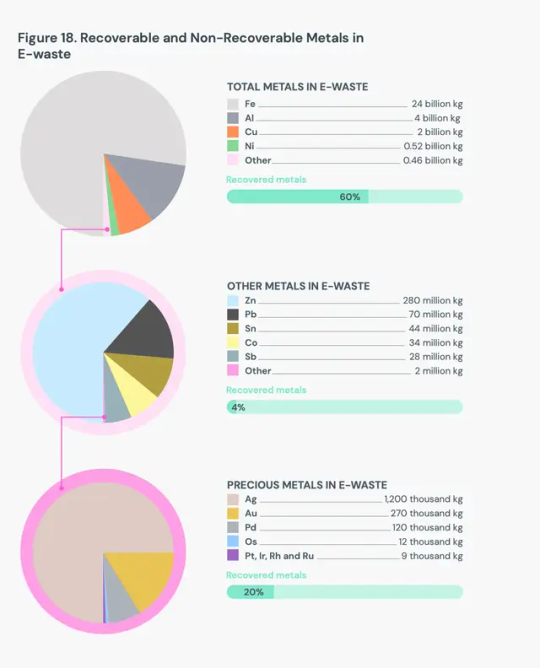
E-waste is a complex thing to break down: A washing machine is made of totally different components than a TV. And even for product categories, not only do different brands use different manufacturing processes, but even different models within those brands vary significantly. A new washing machine has way more sensors and other electronics than one built 30 years ago.
Complicating matters even further, e-waste can contain hazardous materials, like cobalt, flame retardants, and lead. The report found that each year, improperly processed e-waste releases more than 125,000 pounds of mercury alone, imperiling the health of humans and other animals. “Electronic waste is an extremely complex waste stream,” says Vanessa Gray, head of the Environment and Emergency Telecommunications Division at the UN’s International Telecommunication Union and an author of the report. “You have a lot of value in electronic waste, but you also have a lot of toxic materials that are dangerous to the environment.”
That makes recycling e-waste a dangerous occupation. In low- and middle-income countries, informal e-waste recyclers might go door-to-door collecting the stuff. To extract valuable metals, they melt down components without proper safety equipment, poisoning themselves and the environment. The new report notes that in total, 7.3 billion pounds of e-waste is shipped uncontrolled globally, meaning its ultimate management is unknown and likely not done in an environmentally friendly way. Of that, high-income countries shipped 1.8 billion pounds to low- and middle-income countries in 2022, swamping them with dangerous materials.
High-income countries have some of this informal recycling, but they also have formal facilities where e-waste is sorted and safely broken down. Europe, for example, has fairly high formal e-waste recycling rates, at about 43 percent. But globally, recycling is happening nowhere near enough to keep up with the year-over-year growth of the waste. Instead of properly mining EEE for metals, humanity keeps mining more ore out of the ground.
Still, the report found that even the small amount of e-waste that currently gets recycled avoided the mining of 2 trillion pounds of ore for virgin metal in 2022. (It takes a lot of ore to produce a little bit of metal.) The more metals we can recycle from e-waste, the less mining we’ll need to support the proliferation of gadgets. That would in turn avoid the greenhouse gases from such mining operations, plus losses of biodiversity.
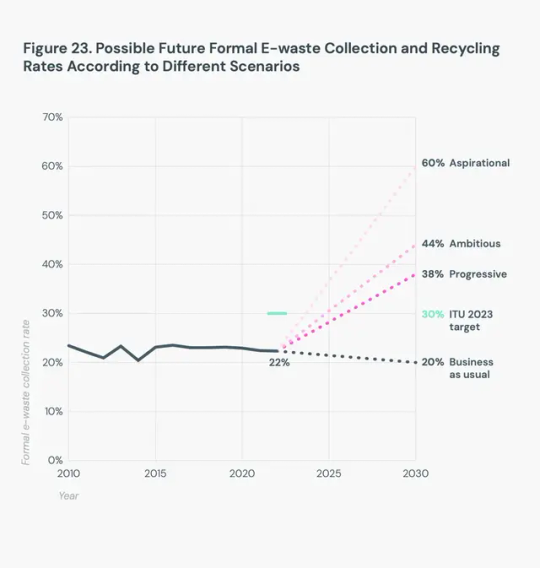
The complexity of e-waste, though, makes it expensive to process. As the chart above shows, even an ambitious scenario of a formal e-waste collection rate in 2030 is 44 percent. “There is no business case for companies to just collect e-waste and to make a profit out of this in a sustainable manner,” says Baldé. “They can only survive if there is legislation in place which is also compensating them.”
The report notes that 81 countries have e-waste policies on the books, and of those, 67 have provisions regarding extended producer responsibility, or EPR. This involves fees paid by manufacturers of EEE that would go toward e-waste management.
Of course, people could also stop throwing so many devices away in the first place, something right-to-repair advocates have spent years fighting for. Batteries, for instance, lose capacity after a certain number of charge cycles. If a phone can’t hold a charge all day anymore, customers should be able to swap in a new battery. “Manufacturers shouldn't be able to put artificial limitations on that ability,” says Elizabeth Chamberlain, director of sustainability at iFixit, which provides repair guides and tools. That includes limiting access to parts and documentation. “Repair is a harm-reduction strategy. It's not the be-all-end-all solution, but it's one of many things we need to do as a global society to slow down the rate at which we're demanding things of the planet.”
At the core of the e-waste crisis is the demand: A growing human population needs phones to communicate and fridges to keep food safe and heat pumps to stay comfortable indoors. So first and foremost we need high-quality products that don’t immediately break down, but also the right to repair when they do. And what absolutely can’t be fixed needs to move through a safe, robust e-waste recycling system. “We are consuming so much,” says Baldé, “we cannot really recycle our way out of the problem.”
26 notes
·
View notes